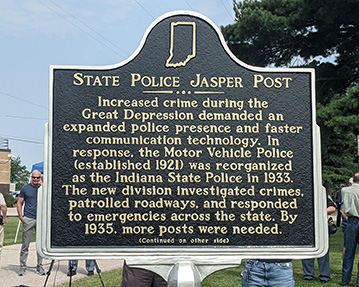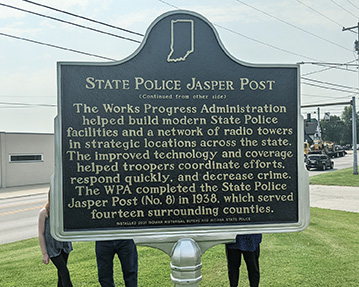

Location: Indiana State Police Post 34, 2209 Newton Street, Jasper (Dubois County, Indiana) 47546
Installed 2021 Indiana Historical Bureau and Indiana State Police
ID#: 19.2021.1
Text
Side One:
Increased crime during the Great Depression demanded an expanded police presence and faster communication technology. In response, the Motor Vehicle Police (established 1921) was reorganized as the Indiana State Police in 1933. The new division investigated crimes, patrolled roadways, and responded to emergencies across the state. By 1935, more posts were needed.
Side Two:
The Works Progress Administration helped build modern State Police facilities and a network of radio towers in strategic locations across the state. The improved technology and coverage helped troopers coordinate efforts, respond quickly, and decrease crime. The WPA completed the State Police Jasper Post (No. 8) in 1938, which served fourteen surrounding counties.
Annotated Text
Side One
Increased crime during the Great Depression demanded an expanded police presence and faster communication technology.[1] In response, the Motor Vehicle Police (established 1921)[2] was reorganized as the Indiana State Police in 1933.[3] The new division investigated crimes, patrolled roadways, and responded to emergencies across the state.[4] By 1935, more posts were needed.[5]
Side Two
The Works Progress Administration helped build modern State Police facilities and a network of radio towers in strategic locations across the state.[6] The improved technology and coverage helped troopers coordinate efforts, respond quickly, and decrease crime.[7] The WPA completed the Jasper State Police Post (No. 8) in 1938, which served fourteen surrounding counties.[8]
[1] Indiana State Police, Indiana State Police, 1921-1937, pamphlet, August 5, 1937, Indiana State Police Museum Archives, 52; “To Start Construction of Police Radio Station,” (Greenville) Daily Banner, September 6, 1934, Newspapers.com; Paul Musgrave, “‘A Primitive Method of Enforcing the Law’: Vigilantism as a Response to Bank Crimes in Indiana, 1925-1933,” Indiana Magazine of History 102, Issue 3 (September 2006): 187-219, https://scholarworks.iu.edu/journals/index.php/imh/article/view/12214.
State officials, police, and banking heads especially identified bank robberies as something could be stopped by police if communication technology improved. Al G. Feeney who would become head of the Indiana State Police (and later mayor of Indianapolis), stated in 1934 that a statewide communication network would be the “greatest step toward solution of the crime problem in Indiana.” He continued: “There have been countless holdups and bank robberies which could have been averted or quickly solved had we been operating a state police radio system.” According to an institutional history produced by the Indiana State Police in 1937: “Born of necessity in the depths of a great economic depression and fostered by the fact that criminals, especially bank robbers, were running roughshod over the highways of Indiana, a statewide police radio network was first conceived in the minds of officials of the State Department of Safety, the Indiana Banker’s Association, and business and professional men.”
[2] Indiana House of Representatives, “A Bill for an Act Concerning Automobiles, Motor Vehicles and Other Motor Driven Vehicles,” House Bill No. 165, Indiana State Archives, copy in IHB marker file; “An Act Concerning Automobiles, motor vehicles and other motor driven vehicles,” approved March 11, 1921; Indiana House of Representatives, “A Bill for an Act Concerning Automobiles, Motor Vehicles and Other Motor Driven Vehicles,” House Bill No. 165, Indiana State Archives, copy in IHB marker file; “A Bill for an Act Concerning Automobiles, Motor Vehicles and Other Motor Driven Vehicles,” Passed March 5, 1921, Journal of the Indiana State Senate During the Seventy-Second Session of the General Assembly, (Fort Wayne Printing Company, 1921), 963, accessed GoogleBooks;“State Police to Aid in Rounding Up Auto Thieves,” Greencastle Herald, July 20, 1921, 1, Hoosier State Chronicles.
[3] Indiana General Assembly, “An Act Creating the Indiana State Police . . .” Enrolled Act No. 468, Approved February 28, 1933, Indiana State Archives, copy in IHB marker file also accessible HathiTrust; “Power of State Police Widened; M’Nutt Controls,” Indianapolis Star, March 1, 1933, 1, Newspapers.com; “Cites Need of Radio,” Indianapolis Times, October 27, 1933, 1, Hoosier State Chronicles.
While newspapers often referred to the Motor Vehicle Police (MVP) as the “state police” earlier than 1933, the MVP only dealt with patrolling highways motor vehicle related crime. In 1933 the General Assembly officially reorganized the MVP to create the Indiana State Police. This 1933 act also gave the police broader powers (see footnote 4). The new agency would use modern communication technology to combat all sorts of crime, especially bank robberies.
[4] Indiana General Assembly, “An Act Creating the Indiana State Police . . .” Enrolled Act No. 468, Approved February 28, 1933, Indiana State Archives, copy in IHB marker file; Indiana State Police, 1921-1937, Indiana State Police Museum Archives, 60; “Jasper Post: The Evansville Tragedy,” The Shield (1943), 47, Indiana State Police Museum Archives; “Auto Crash Fatal to Eugene Beck,” (Jasper) Herald, July 7, 1947, 1, Newspapers.com; “Officers Probe $12,000 Robbery,” Bedford Daily Times-Mail, August 15, 1949, 1, Newspapers.com; “Police Search for 19-Year-Old Youth,” Bedford Daily Times-Mail, November 7, 1950, 8, Newspapers.com; “Police Deserve Credit for White’s Conviction,” Bedford Daily Times-Mail, November 13, 1952, 22, Newspapers.com; “Three Men Are Nabbed for Switz City Holdup,” Linton Daily Citizen, May 1, 1956, 1, Newspapers.com; Indiana State Police, Indiana Police Newsletter (April 1960), Indiana State Police Museum Archives; “Pilot Unhurt as Jet Crashes Downstate,” Indianapolis Star, January 6, 1963, 21, Newspapers.com; “Crackdown on Illegal Trucks Planned by Local State Police,” (Jasper) Herald, January 24, 1984, 2, Newspapers.com;
The 1933 Act of the General Assembly that created the Indiana State Police invested them with “all necessary police powers to enforce the provisions of the laws of the State of Indiana for the regulation and use of automobiles,” other vehicles, the highways, and for preventing crime and apprehending criminals. It also tasked them with responding to emergencies. Newspaper articles and internal newsletters cited in this footnote provide examples of how the Indiana State Police at the Jasper Post have investigated crimes, patrolled roadways, and responded to emergencies across the state.
[5] “To Start Construction of Police Radio Station,” (Greenville) Daily Banner, September 6, 1934, Newspapers.com; Indiana General Assembly, “An Act to Amend Sections 1, 2, 3, 4, and 5 of an Act creating the Indiana State Police . . .” Enrolled Act No. 148, Approved March 13, 1935, Indiana State Archives, copy in IHB marker file; “Radios Linked in Great Fight Against Crime,” Hammond Times, November 22, 1935, 29, Newspapers.com.
[6] “Report of the Division of Public Safety,” Year Book of the State of Indiana for the Year 1935 (Indianapolis: Wm. B. Buford, 1935) 2-7, HathiTrust;
Don F. Stiver, Director, Indiana State Police, “Report of the Division of Public Safety,” July 1, 1935 to June 30, 1936, Yearbook of the State of Indiana for the Year 1936 (Indianapolis: Wm. B. Buford Printing Co.: 1936), 2-8, HathiTrust; Indiana State Police, 1921-1937, Indiana State Police Museum Archives, 52.
The Federal Emergency Relief Administration (FERA) began Construction on the first police post with radio tower in Indianapolis in 1934. In Jasper, FERA established a temporary transmitting location in 1935. Also in 1935, the Works Progress Administration (WPA) replaced FERA. Over the next several years, more posts were established across the state, including the permanent post at Jasper. See footnote 8.
[7] “Crime Wave in State Broken M’Nutt States,” Vidette-Messenger of Porter County, October 21, 1935, 1, Newspapers.com; “Crime in Indiana Has Diminished Since Operation of State Police Radio System,” Culver Citizen, September 1, 1937, 5, Newspapers.com; Don F. Stiver, Director, Indiana State Police, “Report of the Division of Public Safety,” July 1, 1937 to June 30, 1938, Yearbook of the State of Indiana for the Year 1938 (Indianapolis: Wm. B. Buford Printing Co.: 1938), 764-765, HathiTrust.
In 1934 there were twelve bank robberies. By 1937, the State Police had decreased crime, notably bank robberies, by forty percent in large part due to the use of the widespread communications network. By 1938, there was only one bank robbery in Indiana.
[8] Indiana State Police, 1921-1937, Indiana State Police Museum Archives, 24, 52; “Crime in Indiana Has Diminished Since Operation of State Police Radio System,” Culver Citizen, September 1, 1937, 5, Newspapers.com; “Police Radio Station WPHU Ready for Occupancy,” Jasper Herald, January 28, 1938, 1, submitted by applicant, copy in IHB marker file; “New Jasper Post,” The Shield (Spring 1938), 16-17, Indiana State Police Museum Archives; “Report of the Division of Public Safety,” July 1, 1937 to June 30, 1938, Yearbook of the State of Indiana for the Year 1938 (Indianapolis: Wm. B. Buford Printing Co.: 1938), 764-765, HathiTrust; Indiana State Police, “District 34 – Jasper,” https://www.in.gov/isp/3160.htm.
The WPA completed the new post with radio tower at Jasper in 1938. It was one of five posts that was a combination state police station and radio transmitter. Indiana State Police newsletter The Shield reported in 1938, that the new Jasper Post was located on a high hill for better radio transmission in the center of 14 counties. State Police could reach any part of this district in 45 minutes. The designation of “Post No. 8” was transferred from Evansville to Jasper when it opened in 1938. The Indiana State Police posts were redistricted several times, before the current fourteen districts were established by 1971. The Jasper Post, still operating in the original WPA building is now Post 34.
Keywords
Government Institution, Law, Buildings & Architecture
